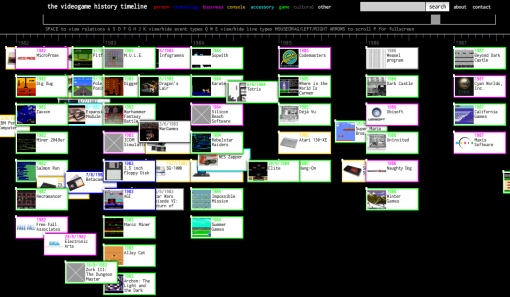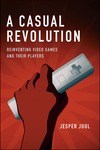If you never found the five minutes to play Jason Rohrer’s Passage, previously discussed, you can now play Passage in 10 Seconds as interpreted by Marcus Richert. Thanks to Jason Scott for the link.
“Geração sobre a fala” / “My Generation about Talking”
“Geração sobre a fala” (“My Generation about Talking,” Nick Montfort) Tradução para o português, Cicero Inacio da Silva.
“My Generation about Talking,” a text generator which I first presented at the Software Studies Workshop on May 21, 2008, is now available in Portuguese translation, thanks to Cicero Inacio da Silva. It was made for use in a presentation, but the program is set up to allow a user to play the entire presentation or to access any of the fifteen individual voices, each of which affirms repeatedly in some way.
The program is in Python and will run from the command line in OS X and on many Linux systems. It will run on Windows after Python for Windows has been installed.
For instance, to run the English version of this program on OS X:
- Download yes_voices.py to the desktop; if you download it to another location, move the file to the desktop.
- Start the Terminal application and open a terminal window. An easy way to do this: Click on the Spotlight magnifying glass in the upper left, type “terminal”, and select the Terminal application. A window will open.
- In the terminal window, type “cd Desktop” and press return to change directories to the desktop.
- Type “python yes_voices.py” and press return.
DAC09 Proceedings Now Online
Proceedings of the Digital Arts and Culture Conference, 2009 are now online. The conference was a great success; DAC continued to lead the way in the culturally engaged study of digital art and media. Many thanks go to Simon Penny, who was director of the conference, and others at UIC: Ward Smith, Liz Losh, and Sean Voisen. The theme leaders for this conference put together very strong series of papers that were both focused and relevant. I hope those of you who didn’t make it to Irvine will visit the proceedings and see a bit of what happened at the latest instance of this extraordinarily rich series of gatherings, where the study of video games, digital art, digital literature, performance, and the cultural aspects of online and computing experience have been explored so well over the years.
Up Above Once Again
 I’m back from a nice slice of summer in Sydney, Australia. I spoke at the University of New South Wales when I was there, gave two talks at the Powerhouse Museum in connection with their “The 80s Are Back” exhibit, and was one of the three judges of the Global Game Jam Sydney. The people who participated in that event did some incredible work – congratulations to all. Here’s some video of me, at the Powerhouse Museum, on interactive fiction and on indie and 80s videogames.
I’m back from a nice slice of summer in Sydney, Australia. I spoke at the University of New South Wales when I was there, gave two talks at the Powerhouse Museum in connection with their “The 80s Are Back” exhibit, and was one of the three judges of the Global Game Jam Sydney. The people who participated in that event did some incredible work – congratulations to all. Here’s some video of me, at the Powerhouse Museum, on interactive fiction and on indie and 80s videogames.
Videogame Timeline
Mauricio Giraldo Arteaga has completed a beta version of his extensive and well-designed Videogame Timeline. He’s also written a blog post about the project, in Spanish. (Update: Mauricio has posted an English translation.) The timeline contains people, technologies, businesses, platforms, accessories, and games and has a mode that shows connections between these items.
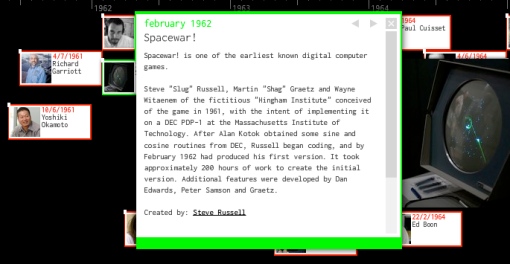
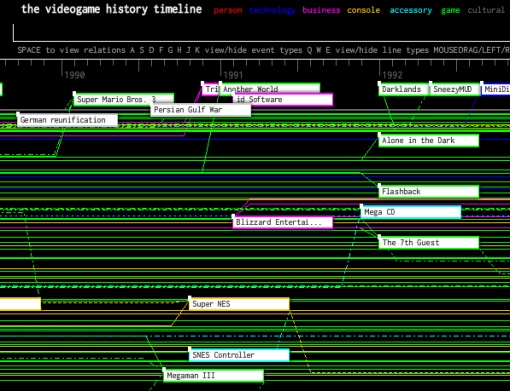
“Les deux” / “The Two”
[English follows…]
Mon générateur d’histoires “The Two” est désormais en ligne avec une traduction française, “Les deux” , de Serge Bouchardon. La version anglaise était auparavant disponible en Python. C’était le second de trois générateurs de 1k que j’avais réalisés à la fin de 2008. “Les deux” génère des histoires toutes simples de trois lignes, mais dont l’effet de sens n’est peut-être pas si simple. Les versions anglaise et française sont à présent disponibles en JavaScript et sont ainsi facilement accessibles sur le Web.
My story generator, “The Two,” is now online along with a French translation, “Les deux,” by Serge Bouchardon. The English version of the story was previously available in Python. It was the second of three 1k story generators that I wrote near the end of 2008. “The Two” generates three-line stories in a straightforward way, although the effect may not be straightforward. Both French and English versions are now available in JavaScript, so they can be run from the Web easily.
A Note on the Word “Zork”
Yes, It’s a Nonsense Word
The lowdown on Zork‘s name, inasmuch as a lowdown has been provided in print, was given by authors Dave Lebling, Marc Blank, and Tim Anderson in 1979 in the article “Zork: A Computerized Fantasy Simulation Game,” Computer 12:4, 51-59 (April 1979):
The first version of Zork appeared in June 1977. Interestingly enough, it was never “announced” or “installed” for use, and the name was chosen because it was a widely used nonsense word, like “foobar.”
This is a clear explanation, but it raises the question of how this particular nonsense word came into wide use at MIT. It seems reasonable to pursue this question, and reasonable that there would be some discernable answer. After all, there’s a whole official document, RFC 3092, explaining the etymology of “foobar.” It could be interesting to know what sort of nonsense word “zork” is, since it’s quite a different thing, with very different resonances, to borrow a “nonsense” term from Edward Lear or Lewis Carroll as opposed to Hugo Ball or Tristan Tzara. “Zork,” of course, doesn’t seem to derive from either humorous English nonsense poetry or Dada; the possibilities for its origins are more complex.
Slouching from “Zorch”?
In the first part of “The History of Zork,” The New Zork Times 4:1 (Winter 1985), Tim Anderson adds to the earlier discussion and suggests a possible derivation for the word:
Zork, by the way, was never really named. “Zork” was a nonsense word floating around; it was usually a verb, as in “zork the fweep,” and may have been derived from “zorch.” (“Zorch” is another nonsense word implying total destruction.) We tended to name our programs with the word “zork” until they were ready to be installed on the system.
“Zorch” is listed in Peter R. Samson’s 1959 “TMRC Dictionary” – the dictionary of the Tech Model Railroad Club, an organization that was important in helping to begin and foster recreational computing. The term meant, at that time, “to attack with an inverse heat sink” – that is, to attack with a heat source – and is explained as “Another of David Sawyer’s sound effects, which I reinterpreted as a colorful variant of ‘scorch.'” It could also be imagined as a variant of “torch” – either way, the application of heat is suggested. This definition is consistent with the sense of “zorch” that Anderson gives, although a bit more specific. It is quite possible that “zork” does derive from “zorch,” as Anderson and others guess, but it is not clear why a word so derived would then be used as a placeholder program name. It’s also at least arguable that “zork” sounds less destructive than “zorch,” as the unintimidating back-formations “scork” and “tork” suggest. If that’s the case, why would a less intense term come to be used when the original term is more intense and very comical? While the “zorch” etymology might be right, it at least seems worthwhile to look to other possibilities.
Textbook Examples
“Zork” occurs occasionally, although rarely, as a proper name in various print sources in the decades leading up to 1977. Google Book Search reveals that some more nonsensical uses occur in some textbook examples in the 1970s. In Introduction to Experimental Psychology by Douglas W. Matheson, Richard Loren Bruce, and Kenneth L. Beauchamp (1970, 2nd. ed 1974) the meaningless “zork” model is introduced as a contrast to a medical model. “Zork” is also used as a fictional place name in Henry F. DeFrancesco’s 1975 Quantitative Analysis Methods for Substantive Analysts. There is some chance that the term was picked up from such a source. Zork explicitly pokes fun at the material nature of textbooks by including a “this space intentionally left blank” joke, which refers to a message sometimes printed on textbook’s blank pages to let readers know that they have not been left blank due to a printing error. Given this, it would be hard to rule out to possibility of the term “zork” coming from a textbook. Of course, the term could have appeared at MIT indirectly, in an example given in a lecture, on a problem set, or on a test, even if a book with the example in it was not assigned as a text. But there is nothing to strongly recommend this etymology, either. And while the former textbook example is clearly the more vivid, it is also much less likely to have been encountered by the Zork authors, [updated January 10] since they were involved with a computer science research group, Dynamic Modeling. MIT does not now have a department named psychology, but Course 9 (now Brain and Cognitive Sciences) was called Psychology from 1960-1985.
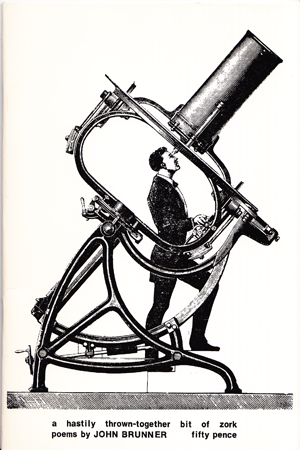
There has been some speculation – specifically, in this mailing-list thread – that the term “zork” may come to MIT via John Brunner, whose poetry chapbook A Hastily Thrown-Together Bit of Zork was published in 1974. Although the sense of the word as it appears in the title is completely consistent with the MIT meaning of the term, it is not clear that this 24-page pamphlet, published by Square House Books in an edition of 200 (50 numbered and signed), had made it to MIT by the time Zork coalesced, beginning in 1977. Nevertheless, the idea of a science-fictional vector for the term is appealing.
How Brunner Happened upon “Zork”
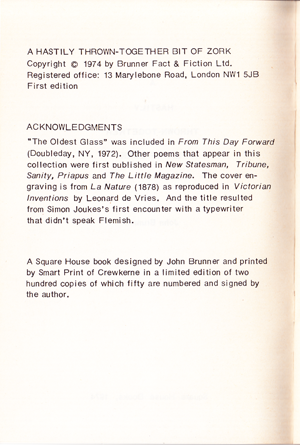
On the unnumbered second page of A Hastily Thrown-Together Bit of Zork, Brunner notes that “the title resulted from Simon Joukes’s first encounter with a typewriter that didn’t speak Flemish.” According to this history of Dutch and Flemish fandom, Simon Joukes was active in Flemish fandom and was a part of the club Sfan, helping to publish Info-Sfan, which became SF Magazine.

Here is a Belgian typewriter, manufactured by Olivetti. (This blog post is the source for the image.) The letters are laid out just as they are on a French typewriter, in the AZERTY scheme. As you can see, if you’ve learned to type the word “WORK” on a typewriter like this, and someone then substitutes a British (or US) typewriter without your noticing, and you then try to type that word without looking at the keys, you’ll type “ZORK.” (Since the “W” and “Z” are switched in this layout, the same thing would happen to a British typist who uses to a Belgian typewriter without noticing how the keys are labeled.)
It’s particularly appealing that this etymology makes zork an altered form of, or an alternative to … work.
Another Science-Fiction “Zork”
Brunner’s use of “zork” in the title of his book was not the first appearance of the word in science fiction. The word made an appearance earlier in Lin Carter’s novel The Purloined Planet, published in 1969. It was used in the name of an important character … “Zork Arrgh.”

It’s likely that Brunner at least glanced at the name of this key character. Lin Carter’s novel was published in a Belmont Double edition with “two complete science fiction novels.” The other was Brunner’s The Evil That Men Do.
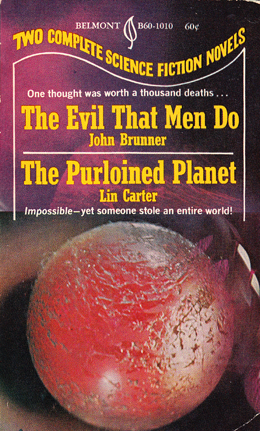
While Simon Joukes may have typed out the word “Zork” and directly inspired Brunner’s 1974 title, the word may have rang out to Brunner as interesting and particulaly amusing because of Carter’s earlier use of it.
“Zork” and How She Is Spoke
There is some chance that people at MIT saw Brunner’s slim book of poems, but it seems far from certain. As of this writing, WorldCat lists only four university libraries in the United States that have this limited-edition book. MITSFS, the MIT Science Fiction Society, boasts the world’s largest open-stack library of science fiction and has 83 titles by Brunner in its catalog – but A Hastily Thrown-Together Bit of Zork is not among these. The Evil That Men Do / The Purloined Planet is in the collection, however.
Even when all of these additional leads are considered, it seems there is no strong conclusion to be drawn about the deeper etymology of the name of MIT’s, and Infocom’s, most famous text adventure. “Zork” might have been a corruption or further development of “zorch.” It may have entered the argot because of its use in an amusing curricular example, perhaps thanks to Quantitative Analysis Methods for Substantive Analysts or another textbook that hasn’t yet been ingested into Google Books. Or, science fiction may have been the vector for the word. If it was, though, it seems likely that it made its way into MIT speech not because of Brunner’s book of poems, but thanks to Zork Arrgh, a key character in 1969 novel by Lin Carter, one that was sitting on the shelves at MITSFS.
Perhaps more evidence will come to light, and the origins of the word “zork” as it was used at MIT in the late 1970s will become clear. Or, it may be that the origins of the word are lost forever – obliterated in a nook of a subculture’s linguistic history that has been irreversibly zorched.
A Casual Revolution
Juul’s latest, like his Half-Real, offers many insights, particular and general, while being succinct and clear stylistically. The book is not just about matching tile games, although there’s a good chapter on them and their genealogy. It’s about the moment in the history of videogaming where games overflow their “hardcore” niche and begin to appeal to everyone. Juul describes the stereotypes of casual and hardcore games and players; then he demonstrates, using data from many interviews, exactly how they’re wrong. An important, high-level innovation involves figuring out how to study both games and players – in this case, to understand what exactly is meant by “casual games” and how much of what we associate with that has to do with “causal” modes of play. There’s also an excellent analysis of the social space of play in front of the screen, in Guitar Hero and Wii games. A Casual Revolution will be valuable for academics and those in industry, and will help keep the sun shining on games.
Micro Art Machines
Here are some tiny bits of code to generate some amusement and aesthetic value.
The album sc140 features 22 tracks, each one generated by no more than 140 characters of SuperCollider code. You can download 80 MB of MP3 (for the weak!) or grab the source code (less than 4 KB, with all the formatting) and, if necessary, install SuperCollider, which is free in every sense. Here’s a November New Scientist blog post about the album.
On the visual and literary side, check out Pall Thayer’s Microcodes, tiny art pieces in Perl. Thayer also offers a PDF guide to the appreciation of tiny programs. Some of Thayer’s program incorporate play with the human-legible dimension of code; “WAR has NO value,” now on the front page, is a simple and nice example of this.
IGF Finalists Announced
The 2010 Independent Games Festival finalists have been announced. Especially interesting to me are the finalists and honorable mentions for the IGF Nuovo Award, an award intended to “honor abstract, shortform, and unconventional game development which advances the medium and the way we think about games.” My collaborator, Ian Bogost, has a game in the finals: A Slow Year, a suite of four 1k games for one of his, and my, favorite platforms … which means that he’ll be brining an Atari 2600 to GDC this year to display his wares.
Every Day the Same Dude
From a 4 January 2010 conversation between Mary Flanagan and Nick Montfort:
nick: so, I just have this question about the way you (and someone else) reacted to gender stereotyping in a nightmarish/dystopian/stereotypical game environments
nick: you wrote While there are some glaring stereotypes that take away from its freshness and originality (especially in regard to gender; the character’s wife is in the kitchen with a frying pan in the morning and tells the character he is late for work; the office execs are all male, etc.) about Every Day the Same Dream [previously on Post Position]
nick: it struck me because I was describing a student project to a poet
mary: y
nick: one which was completed before that game launched
nick: but had a similar stereotyped/nightmare world made of words in 3D space
nick: one of which was “wife”
nick: and my poet friend said “spouse”!
mary: ok….
nick: but I don’t understand why these negative-valence spaces that embody stereotypes in all these other ways
nick: are supposed to be equitable when it comes to gender
mary: well…
mary: I am not partial to other stereotypes either
mary: unless they are spoofed in incredibly interesting ways
mary: but
nick: I read Every Day the Same Dream as having entirely white people, too
mary: for example if I brought them all up all the time, I’m a horrible harpy broken record, and that isn’t my point in life. But not bringing things up = acceptance
mary: yes exactly
mary: I agree and I had that in there and then cut it out.
mary: for reason above.
nick: well, I guess I would point those things out as being consonant with the project rather than as taking away from it
nick: the game (and my student’s project) seems to be saying “here is an even more exaggerated version of the stereotypical world”
mary: well that could be. But everdayness, monotony, boredom could be happening to two people following that routine, two men, women, or one of each if we’d like. Or three for that matter. It just the frying pan and housewife just needs to go.
nick: well, they do, eventually &smiley;
mary: Since there are more women than men, why could not the character be a woman going to a drudge job?
nick: but you’re trying to make the game an image of reality instead of nightmare hegemony
mary: you could make the office workers men and women of different races
mary: it annoys me — I have not collected the numbers, but it annoys me that existentialist moments appear to happen more with male characters. 1984. etc.
nick: then, I’d argue, the game would not become more realistic or effective; it would have this sort of parody of workplace diversity in it
mary: well I did add diversity to the LAYOFF game. Everyone started white, the artist (who was Asian) defaulted to white)
mary: well then perhaps that would speak to me as a player as an effective parody
mary: mock diversity says something else, and is interesting. especially in college ads.
nick: yes, but I see that (LAYOFF) as trying to poke a hole through the abstract, we-don’t-expect-this-to-represent-reality type of game to show something about the real world
nick: which is admirable, but it isn’t the same project as these other games
mary: I guess I am rejecting the repeated aesthetic of abstract commentaries that use a represention of all white men.
nick: I’m asking because I’ve heard the same comment twice about the same type of game, from two people whose perspectives I very much respect, but I don’t understand the problem with this particular context – with a dystopian game exhibiting sexism among other stereotypical ills
mary: ah ok
nick: so it’s not that the sexist portrayal is wrong for the context, but that you could have made a different game which made the same point without it?
nick: maybe?
mary: yep
mary: and possibly a more interesting game, through reworking or challenging these stereotypes
mary: but that remains to be seen in implementation
nick: Jason Rohrer gets complaints about Passage having only a guy avatar as an option
mary: i can see that.
nick: of course, he also has described Passage as autobiographical (although I argue with his use of that term)
mary: it’s not automagically horrific to include men in a game!
nick: sure, and it’s not automatically good in every way to include a hot chick avatar
mary: right.
mary: it is about intentionality
mary: and I don’t think molleindustria was intentionally critiquing white heterosexuality.
mary: in fact…
nick: do you think if the sexism in Every Day the Same Dream were somehow called out as such (I don’t have any ideas about how), and critiqued, it would be better?
nick: perhaps even better than making a gender-neutral version?
mary: possibly!
mary: but that isn’t the point right now.
mary: of that game.
nick: I’d say it was being critiqued about as much as the automobile was
mary: and granted, 6 days, its a miracle.
nick: yep
nick: well, it’s worthwhile to think about how to improve on a 6-day project like that, though
mary: Hm. It feels different. The automobile isn’t on the receiving end of dates who have sexist attitudes, or jobs with racial bias. Possibly certain critiques are touchier than others.
nick: I guess my feeling is that a sexist world (treated critically) would be more in keeping with the project, or with a project like that, than a gender-neutral one
nick: maybe it’s easier to critique the automobile
mary: that could be true. Then husband and wife could both go to work, but he brings home twice the salary and she still has to cook
mary: that makes it more interesting to me.
nick: ha
mary: it pays attention to a lived condition.
mary: a detail. see what i mean. could be the same for race and such. but details are hard to put into ‘dreams’ and broad strokes, unless we think about it cleverly
mary: I appreciate your inquisitveness here nick.
nick: I guess the game includes a lot of stereotypes, and from my standpoint I don’t see it buying into any of them. but some do call for more critique and treatment
nick: I appreciate the convo
mary: Bringing this stuff is actually harder than ignoring it and moving on.
mary: but I think we need to tease out these implications
mary: not all stereotypes are created equally
nick: I think we should do a blog post, actually
mary: ok i’m game.
Short Video & Interview on Interactive Fiction
 Talieh Rohani made a video of about six minutes in which I discuss the basics of interactive fiction and show a few artifacts related to the material history of this form of computer game and digital literature. This video, “Exploring Interactive Fiction,” was made for the recent Jornada de Literatura in Passo Fundo, Brazil, and a subtitled version was screened there. I’m a few months late in putting it on the Tube for anyone else who is interested, but it’s online now.
Talieh Rohani made a video of about six minutes in which I discuss the basics of interactive fiction and show a few artifacts related to the material history of this form of computer game and digital literature. This video, “Exploring Interactive Fiction,” was made for the recent Jornada de Literatura in Passo Fundo, Brazil, and a subtitled version was screened there. I’m a few months late in putting it on the Tube for anyone else who is interested, but it’s online now.
Also, a short interview with me about interactive fiction and computer games is online at RPG Examiner. Thanks to Michael Tresca for his interest, his questions, and for posting the interview.
A Beautiful Game to Start Your 2010
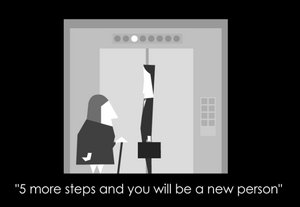 Molleindustria has recently released an excellent short game with the music of Jesse Stiles. In Every Day the Same Dream, you play a man who awakens (continually) to your alarm going off, your clothes waiting to be put on, your television that cannot be watched, your wife who cannot be kissed good morning, traffic, and a seemingly endless cubicle farm where you work. A crone figure in the elevator suggests that you can break away from this routine, somewow. The music hits just the right point between the humdrum repetition of the workday and the idea of an alternative to these. The almost entirely grayscale game doesn’t write a prescription for the player’s happiness, and some of the steps are much sillier than others. Nevertheless, the game hints at how people can explore the everyday and escape the oppression of the ordinary. That’s not bad for six days of game development work and for a few minutes of your time.
Molleindustria has recently released an excellent short game with the music of Jesse Stiles. In Every Day the Same Dream, you play a man who awakens (continually) to your alarm going off, your clothes waiting to be put on, your television that cannot be watched, your wife who cannot be kissed good morning, traffic, and a seemingly endless cubicle farm where you work. A crone figure in the elevator suggests that you can break away from this routine, somewow. The music hits just the right point between the humdrum repetition of the workday and the idea of an alternative to these. The almost entirely grayscale game doesn’t write a prescription for the player’s happiness, and some of the steps are much sillier than others. Nevertheless, the game hints at how people can explore the everyday and escape the oppression of the ordinary. That’s not bad for six days of game development work and for a few minutes of your time.
Literary Generation at DAC
Late yesterday, I wrapped up my long (and very fun) day at Digital Arts and Culture 2009 in Irvine by presenting my paper “The ppg256 Series of Minimal Poetry Generators” in the late afternoon cognition and creativity panel and then by being a part of the extraordinary DAC Literary Arts Extravaganza, quickly presenting selections that I called “Five Uneasy Pieces:”
- “The Purpling,” a prose poem in hypertext
- The Marble Index (a work in progress in the interactive fiction system Curveship)
- “Taroko Gorge,” a poetry generator originally written in 1k of Python
- “The Two,” a 1k Python story generator (on the screen, I premiered the French translation by Serge Bouchardon – links to both coming soon)
- “ppg256-2,” one of my 256-character Perl poety generators which my paper discusses
Interactive Fiction Platforms, Strong Bad’s Upgrades
Alex Mitchell just did a great job of presenting the work he and I did on the influence of interactive fiction platforms: “Shaping stories and building worlds on interactive fiction platforms.” We looked at how TADS 2 and Inform 6, which are really extremely similar development systems created to do almost exactly the same things, nevertheless may offer different affordances to IF authors and may influence the way story words (and other aspects of IF) are developed. Check out the full paper if this interests you.
In this panel, which was intriguing overall, I’ll also mention Stephanie Boluk’s fine presentation. She investigated seriality (in a broad sense), melancholy, and the relationship between narrative and database, bringing narratology (among other approaches) to bear on her object of study: Homestar Runner. “Homestar Runner’s far more surreal characters are impossible to locate along any realistic age spectrum. They perform innocence and experience in various degrees, functioning as polysemic signifiers that embrace these contradictory positions – a hybrid condition made possible by their status as cartoons.” Also, a discussion of how Strong Bad’s past computers coming back from the dead resists the dehistoricization of digital media.
Big Day at DAC 2009
Ian Bogost and I just gave our talk “Platform Studies: Frequently Questioned Answers” here at Digital Arts and Culture in Irvine, California. There were three other talks – fascinating ones – in this day’s opening plenary session. Garnet Hertz took us into circuit bending, tactical media, and the artistic recycling and reuse of electronic waste. Jason Farman spoke on locative media with a focus on geocaching as technologically-enabled, embodied, proprioceptive play. Conor McGarrigle explored, in detail and with reference to several specific projects, the relationship between the practices of the Situationist International and contemporary locative media work.
Ian and I addressed six misconceptions about platform studies (the concept, the focus) which we’ve already heard a few times. Our talk was an attempt to better invite people to participate in the project and in the book series. In brief, the six misconceptions, and our responses, are:
#1 Platform studies entails technological determinism.
Platform studies is opposed to “hard” determinism and invites us to continue to open the black box of technology in productive ways.
#2 Platform studies is all about hardware.
Platform studies includes software platforms as well.
#3 Platform studies is all about video games.
Platform studies extends to all computing platforms on which interesting creative work has been done.
#4 Everything these days [in the Web 2.0 era] is a platform.
We invite a focus on computational platforms, the basis for digital media work.
#5 Platform studies is about technical details, not culture.
Platform studies connects technical details to culture.
#6 Platform studies means that everyone in digital media will have to get computer science training or leave the field.
Platform studies shows how technical understanding can lead to new sorts of insights, but will not evict the many other important sorts of scholars from digital media.
The full paper is online, too. Since the beginning of the project, we’ve insisted on the embedding of the platform level in culture and other non-technical contexts, and we’re tried to draw connections between the way computing systems work and culture, history, and society. Others, we’re sure, will have new ways to do that; please, join us in taking up the platform as an focus for digital media studies.
I have one other collaborative paper today, which will be presented by Alex Mitchell: “”Shaping Stories and Building Worlds on Interactive Fiction Platforms.” Then I’ll present “The ppg256 Series of Minimal Poetry Generators.” Finally, I’ll be part of the DAC Literary Arts Extravaganza with a reading called “Five Uneasy Pieces.” I’m looking forward to it all, but I’m sure I’ll be glad to be looking back on it when the day’s done.
You can search Tweetland for #DAC2009 to see what the cool kids are saying about the conference.
IF, Visuality, and Other Bits of DAC
Among the many great presentations here at DAC 2009 at UC Irvine, the paper by Aaron Kashtan, “Because It’s Not There: Verbal Visuality and the Threat of Graphics in Interactive Fiction,” was particularly nice to hear. Aaron discussed my 2000 interactive fiction Ad Verbum, related it to Emily Short’s City of Secrets, and presented a nice argument about how these two engage (differently) with text’s ability to represent the visual. Here’s the abstract:
In this paper I analyze two contemporary works of interactive fiction (IF), Nick Montfort’s Ad Verbum and Emily Short’s City of Secrets, as examples of two contrasting ways in which IF reacts to the perceived threat of computer graphics. In the post-commercial era of IF, graphics represent a factor that, without being acknowledged, has profoundly shaped the development of the medium. Post-graphical works of IF may be distinguished according to how they respond to the threat or promise of graphics. Ad Verbum’s response to graphics is to emphasize the purely textual, and thus anti-graphical and anti-visual, aspects of the medium. The implication is that IF’s closest affinities are not with visual prose but with printed works of procedural textuality, and that IF is a visual medium. By contrast, City of Secrets activates a mode of visuality that depends less on immediate presence than on emotional affect and imaginative participation. Short suggests that IF is a visual medium, but that it differs from graphical video games in that its visuality depends on absence rather than presence.
I was also really impressed by Brett Camper’s discussion of the MSX-inspired “fake 8-bit” game La-Mulana and, on a very different level, the wide-ranging first talk of the conference, by Kate Hayles, which engaged cognition, tools, attention, and evolution.
DAC 2009 has proceedings which were handed out to attendees on CD-ROM and which will be (to some extent?) available. So, while I hope to mention a few more DAC highlights, I won’t aim to summarize talks.


